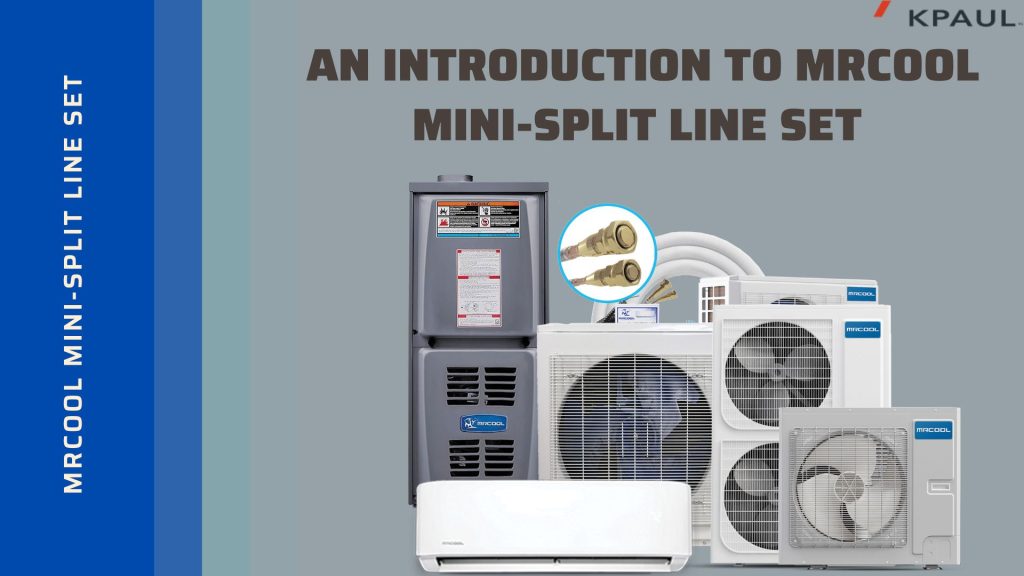The evaporator and condenser of a tiny split line set system are connected by a pair of copper tubes. The line set connects the indoor and outdoor units. By using ductless split system technology, these systems can lessen the environmental impact of delivering conditioned air into interior spaces.
MrCool Mini split system line sets are commonly used in residential, commercial, and institutional settings because they are extremely versatile and may serve a variety of purposes. Mini split line set installations are the answer if you want to install a heating, ventilation, and air conditioning (HVAC) system in a room addition, multifamily housing, or a garage.
What Materials Do Line Sets Contain?
Copper tubing with a medium degree of flexibility makes up refrigerant line sets. They often employ coated or elastomeric insulating materials made of ethylene propylene diene monomer (EPDM). Although line set insulation normally includes an ultraviolet (UV) retardant, the materials can also be coated with another substance for increased resistance to prolonged exposure.
What Are the Uses of a Mini Split Line Set?
One of the lines is always larger than the other in a tiny split-line arrangement. The smaller of the two tubes, known as the liquid or discharge line, conveys the liquid refrigerant to the evaporator, where it draws heat, which accounts for the size difference. The heavier gaseous refrigerant is moved back into the condenser and is rejected by the suction line, the larger the tubes.
In order to provide the proper cooling or heating, depending on the flow direction, the vapor, and refrigerant in the lines continuously recirculate through the system.
Numerous applications exist for tiny splits and mini-split line sets. They are most often used as retrofit additions for homes with non-ducted heating systems, such as radiant panels, hydronic heating systems, and space heaters that burn wood, gas, and kerosene. They are also useful for distribution ductwork for central heating or air conditioning systems, room extensions, and small flats.
Other typical applications for ductless line set systems to comprise:
- older houses or commercial structures without ducting already in place.
- houses with pricey electrical heating systems.
- houses with inefficient central heating systems or those with excessive fuel expenses.
- spaces that aren’t often used.
- development of new buildings in regions with expensive fuel prices.
- areas where ductwork is exposed to extreme temperatures next to unconditioned spaces
- Outbuildings like garages, sheds, and barns where it is not practical to expand the ducting.
What sizes are available for line sets?
A tiny split line is typically 25 feet long. This measurement is the approximate separation between the nearest indoor air handler and the outdoor condenser. The span between the units can be shorter than 15 feet, despite the most typical size; in this case, you’d need a line around the same length. The maximum line length for a small split system is typically 50 feet, but this length is too long for most applications.
A line set’s minimum length and diameter are figured out by the manufacturer as the quantity, the spacing between the units, and the condenser size. For instance, if a manufacturer predicts that most customers will have 20 feet of line between their air handler and condenser, they’ll probably charge the product for that length. The minimum necessary length of the line set is this value. Performance can be affected if the minimum length is not met.
If, however, you need a shorter length of the line than the manufacturer charged for the line set, you can cut part of it. Particularly for split systems, most specialists can add to or remove their refrigerant successfully.
What Number of Line Sets Are Necessary?
Your zoned HVAC system decides how many lines sets you need for your MrCool Mini split. Single-zone and multizone HVAC systems are the two main categories.
Single-Zone
One condenser and one handler are used in single-zone mini-split systems to regulate a single room, reducing energy usage for more affordable and environmentally responsible use. Single zones are perfect for room additions that don’t call for system redesigns, such as an attic or basement conversions. Single-zone systems minimize renovations when used with current central heating and cooling systems.
You can meet the following with single-zone ductless mini-split line systems:
- reduced energy costs
- lower costs for installation.
- more sustainability
- little equipment is needed.
- less need for maintenance and repairs.
- improved performance all around.
Multizone
One outside condenser and many internal air handlers are used in multi-zone installations. Condensers are the best choice for multi-story homes since they can simultaneously control up to eight interior units.
The main advantage of multizone systems is that they let customers use several thermostats to regulate the temperature in various rooms inside a single residence. These customized heating and cooling options reduce the strain on the central heating system and improve occupants’ general comfort. Additionally, vacant spaces won’t use more energy or raise costs.
Utilizing multi-zone small split line systems has more benefits, such as:
- less expensive upkeep.
- capability for remote management.
- fewer outside structures
- total command of temperature.
Kpaul Industrial in partnership with top Brands are one of the leading distributors in the United States of America at the most affordable prices. You will also benefit from ongoing discounts and promotions when placing an order .
blog -https://magzina.com/

